
Begonia is a genus of perennial flowering plants in the family Begoniaceae. The genus contains more than 2,000 different plant species. The Begonias are native to moist subtropical and tropical climates. Some species are commonly grown indoors as ornamental houseplants in cooler climates. In cooler climates some species are cultivated outside in summertime for their bright colorful flowers, which have sepals but no petals.

The garden pansy is a type of polychromatic large-flowered hybrid plant cultivated as a garden flower. It is derived by hybridization from several species in the section Melanium of the genus Viola, particularly V. tricolor, a wildflower of Europe and western Asia known as heartsease. It is sometimes known as V. tricolor var. hortensis, but this scientific name is suspect. While V. tricolor var. hortensisGroenland & Rümpler is a synonym of Viola × wittrockiana, V. tricolor var. hortensisDC. refers to a horticultural variety of wild pansy that had been illustrated in Flora Danica in 1777 before the existence of Viola × wittrockiana.

The Infinite Corridor is a 251-meter (823 ft) hallway that runs through the main buildings of the Massachusetts Institute of Technology, specifically parts of the buildings numbered 7, 3, 10, 4, and 8.
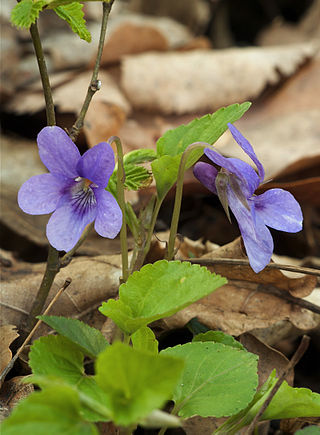
Viola is a genus of flowering plants in the violet family Violaceae. It is the largest genus in the family, containing over 680 species. Most species are found in the temperate Northern Hemisphere; however, some are also found in widely divergent areas such as Hawaii, Australasia, and the Andes.

Cercis canadensis, the eastern redbud, is a large deciduous shrub or small tree, native to eastern North America from southern Michigan south to central Mexico, west to New Mexico. Species thrive as far west as California and as far north as southern Ontario. It is the state tree of Oklahoma. The prevalence of the so-called "Columbus strain" has seen the residents of Columbus, Wisconsin, embrace the plant in their city's identity. Known as the "Redbud City," the town hosts "Redbud Day" annually the Saturday before Mother's Day, organizing a variety of themed events to recognize the tree.

Towson University is a public university in Towson, Maryland. Founded in 1866 as Maryland's first training school for teachers, Towson University is a part of the University System of Maryland. Since its founding, the university has evolved into eight subsidiary colleges with over 20,000 students. Its 329-acre campus is situated in Baltimore County, Maryland eight miles north of downtown Baltimore. Towson is one of the largest public universities in Maryland and still produces the most teachers of any university in the state.

Viola tricolor is a common European wild flower, growing as an annual or short-lived perennial. The species is also known as wild pansy, Johnny Jump up, heartsease, heart's ease, heart's delight, tickle-my-fancy, Jack-jump-up-and-kiss-me, come-and-cuddle-me, three faces in a hood, love-in-idleness, and pink of my john.

Notre Dame of Maryland University is a private Catholic university in Baltimore, Maryland. NDMU offers certificate, undergraduate, and graduate programs for women and men.

Wesley W. Posvar Hall (WWPH), formerly known as Forbes Quadrangle, is a landmark building on the campus of the University of Pittsburgh in Pittsburgh, Pennsylvania, United States. At 744,695 square feet (69,184.4 m2) it is the largest academic-use building on campus, providing administrative offices, classrooms, lecture halls, a food court, and computer labs. The hall sits on the former site of Forbes Field and contains several artifacts, including the former stadium's home plate and one of two surviving Langley Aerodromes.

The King Mongkut's University of Technology Thonburi is a national public engineering and technology university in Thailand, focusing on teaching and research. It is one of nine national research universities (NRU) in Thailand. It is in Bang Mot Sub-district, Thung Khru District, Bangkok. It was founded on 18 April 1960, making it the third oldest engineering school and seventh oldest university in Thailand.

Nandina domestica commonly known as nandina, heavenly bamboo or sacred bamboo, is a species of flowering plant in the family Berberidaceae, native to eastern Asia from the Himalayas to Japan. It is the only member of the monotypic genus Nandina. It is widely grown in gardens as an ornamental plant with a number of cultivars that display bright-red fall foliage in the cool months, and attractive new foliage growth in spring. Although a popular ornamental shrub, the berries are toxic to birds, especially towards the end of the winter when other food sources become scarce.

The Conservatory Garden is a formal garden near the northeastern corner of Central Park in Upper Manhattan, New York City. Comprising 6 acres (24,000 m2), it is the only formal garden in Central Park. Conservatory Garden takes its name from a conservatory that stood on the site from 1898 to 1935. It is located just west of Fifth Avenue, opposite 104th to 106th Streets.
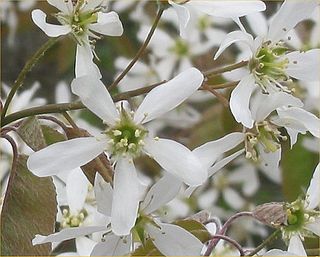
Amelanchier canadensis is a species of Amelanchier native to eastern North America in Canada from Newfoundland west to southern Ontario, and in the United States from Maine south to Alabama. It is largely restricted to wet sites, particularly on the Atlantic coastal plain, growing at altitudes from sea level up to 200 m.
Preston Crossing is a big box power centre in Saskatoon, Saskatchewan, Canada, at Preston Avenue North and Circle Drive.

University Town Center, formerly New Town Center, is located in Hyattsville, Prince George's County, Maryland, United States. It was a planned urban center designed by Edward Durell Stone and located on a 105-acre (0.42 km2) parcel at the intersection of Belcrest Road and East-West Highway and across from the then new Prince George's Plaza. The initial construction on this development took place in 1963–64; its buildings are listed on the National Register of Historic Places. A second phase commenced after the opening of the Hyattsville Crossing station, Washington Metro rapid transit station in 1993.
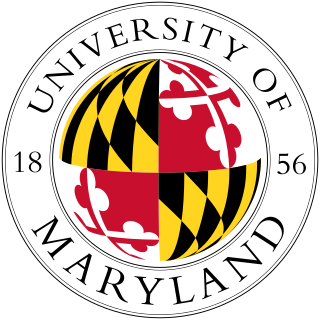
The University of Maryland, College Park is a public land-grant research university in College Park, Maryland. Founded in 1856, UMD is the flagship institution of the University System of Maryland.
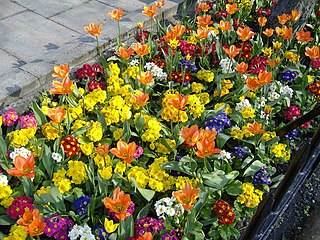
Many types of flowering plants are available to plant in flower gardens or flower beds. The floral industry calls these plants, bedding plants. These fast-growing plants in seasonal flower beds create colourful displays, during spring, summer, fall or winter, depending on the climate. Plants used for bedding are generally annuals, but biennials, tender perennials, and succulents are used.
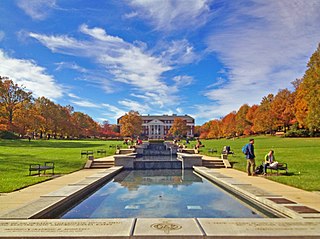
McKeldin Mall is a nine-acre quad in the heart of the campus of the University of Maryland, College Park. Named after Theodore McKeldin, the former Governor of Maryland, McKeldin Mall was considered to be the largest academic mall in the United States on its opening. It has been named one of the most picturesque college campus quads in the nation.

Shuttle–UM is a transit system for the University of Maryland, College Park (UMD), which constitutes the UM acronym of the company, that operates as a unit of the university's Department of Transportation Services. The system is student-run and is supported by student fees and the university's Student Affairs department. Its fleet consists of over 60 vehicles and transports approximately three million rides a year. The system provides four different services: commuter, evening, charter, and demand response. The latter consists of a paratransit service and a call response curb-to-curb service during the evening, while the former consists of a bus service that runs for 24 hours, seven days a week. Implied by its name, the bus service routes "shuttle" passengers to and from the university with over 20 different routes. Paid upon admission by students to the university, the services are complimentary and only certain services require university identification badges. In 2012, the company expanded to provide service to the University of Maryland, Baltimore (UMB) campus under the name, UM Shuttle. Additionally, a new facility was built to house Shuttle–UM's operations and fleet within the campus after over 30 years of being housed off campus.

Campus Drive–UMD is a light rail station that is currently under construction. It will be part of the Purple Line in Maryland. The station will be located at the intersection of Campus Drive and Library Lane on the campus of the University of Maryland.





















